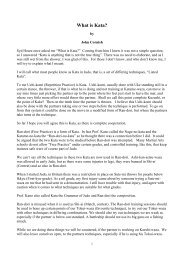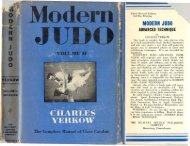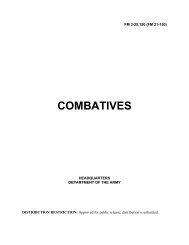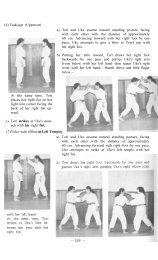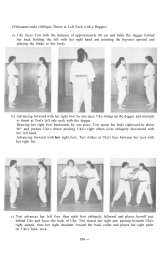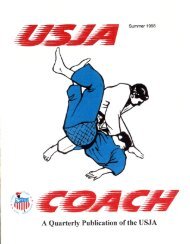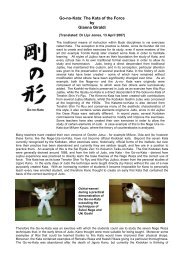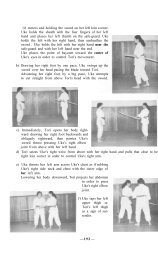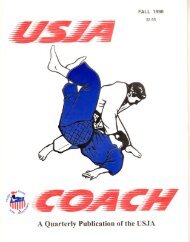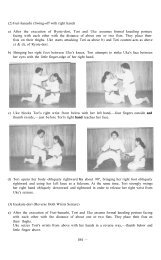USJA Coach - Judo Information Site
USJA Coach - Judo Information Site
USJA Coach - Judo Information Site
- No tags were found...
Create successful ePaper yourself
Turn your PDF publications into a flip-book with our unique Google optimized e-Paper software.
n EItu A. Monell.erhaps one of the mostUnfortunately, most judo plaYerrarely experience this feeling. Why isthis so? Why is it that manythrowing techniques appear to bemechanically correct but require moreeffort than is necessary? In answer toboth these questions in a generalsense, the missing ingredient ismovement on the part of bothplayers, or more specificallp tempo!A very popular misconception injudo circles is that judo skill iscomprised of technique alone. Inother words, only those physical andmechanical moves necessary to movean opponent, are thought to comprisethe total skill. Nothing could befurther from the truth. Technique isonly part of the overall skill. Theremainder is comprised of thosemovements/actions which take placejust prior to reaching the attack point.At this juncture, a definition of thosemovements/actions is in order. Wehave already stated that this is calledtempo. However, as the term"tempo" is over-simplistic, somequalification is needed. TemPoconsists of those movements made bytwo players. It can vary from slow tofast. During an attack, the tsukurisatisfyingilffi:Tff,:#*tfeelings in judo is the exPerienc€ would be the rate ofof performing a throwing change of expendedtechnique with a flawlessexecutionandminimumeffort.action will be part of the tempo. Aenergy by two players'The.wri*1*t:*:"::"reader unoerstanqs tnedefinition of the tsukuri action made bythe attacker. At the end of the tsukuriaction the aftack point is reached. It isat this point that the attacker fullycommits his body weight into theattack. lA/hen the two players aremotionless, the tempo is zero and thetsukuri action must be initiated fromthis zero tempo condition.To more fully appreciate the value ofmovement (tempo), we will attempt ina graphical and qualitative manner todepict those events which take place inthe total skill movement' This will bedone for both the case of tempo existingprior to the tsukuri action and azerotempo condition at the onset of tsukuri.For the purposes of our discussion weshall assume the same attackingtechnique for the finite and zero tempoconditions prior to the tsukuri actionand zero tempo conditions at the onsetof tsukuri. The graphical depiction ofthe foregoing cases are presented inFigure A.The solid curve (time history) of FigureA is similar to that presented in G' R.Gleeson's text entitled "Anatomy offudo". I have introduced a slightmodification to this curve' The Gleesoncurve always has an absolute value oftempo at any given time. What thismeans is that the two PlaYers are inconstant motion. This is virtuallyimpossible. Therefore, those finitetimes when the two plaYers aremotionless have been shown in FigureA by this writer. Superimposed on themodified Gleeson time history is mYversion of the attack situation from thezero tempo condition. We will nowexamine the zero tempo condition insome detail and make comparisons tothe attack with initial temPo. Thetsukuri action for the zero temPo casetakes place during time incrementbetween points 1 and 3. The attackermust now apply the tsukuri action to astationary defender. This means hemust overcome the dead bodY weightof the defender. Since no momentumexists, the attacker must exert muchmore effort than that in Case 1 to reachthe initiation of"attack movementpoint " which is point 3. In addition,the application of the tsukuri action willtake longer than it would for Case 1.Once the deficiency of the lack ofmovement has been overcome with thetsukuri action, a tapering off of efforttakes place until the common "Powerpoint " point 4, is reached. It should benoted that I have chosen to have themaximum power points coincident forthe two cases. The choice wassomewhat arbitrary but certainlYpractical.At this point, an astute reader maY bewondering why the attackingmovement time between points 3 and 4is shorter than the attacking movementtime between points 2 and 4. This isexplained by the fact that at the end of2



